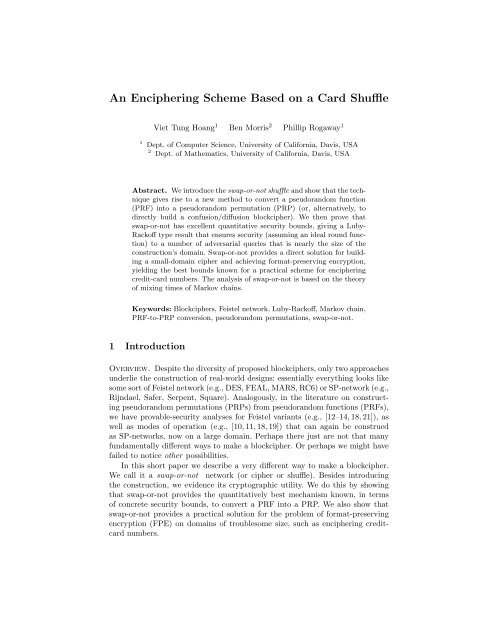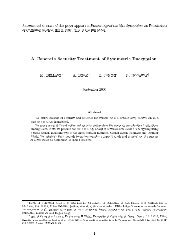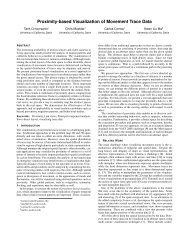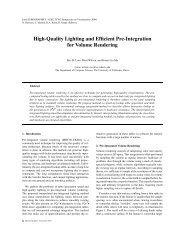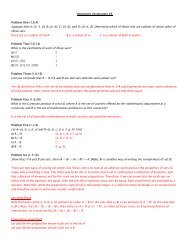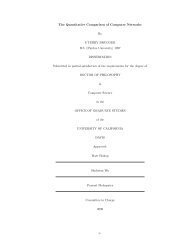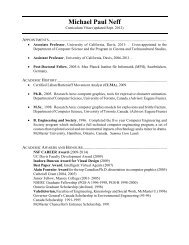An Enciphering Scheme Based on a Card Shuffle - Department of ...
An Enciphering Scheme Based on a Card Shuffle - Department of ...
An Enciphering Scheme Based on a Card Shuffle - Department of ...
You also want an ePaper? Increase the reach of your titles
YUMPU automatically turns print PDFs into web optimized ePapers that Google loves.
<str<strong>on</strong>g>An</str<strong>on</strong>g> <str<strong>on</strong>g>Enciphering</str<strong>on</strong>g> <str<strong>on</strong>g>Scheme</str<strong>on</strong>g> <str<strong>on</strong>g>Based</str<strong>on</strong>g> <strong>on</strong> a <strong>Card</strong> <strong>Shuffle</strong><br />
Viet Tung Hoang 1 Ben Morris 2 Phillip Rogaway 1<br />
1 Dept. <strong>of</strong> Computer Science, University <strong>of</strong> California, Davis, USA<br />
2 Dept. <strong>of</strong> Mathematics, University <strong>of</strong> California, Davis, USA<br />
Abstract. We introduce the swap-or-not shuffle and show that the technique<br />
gives rise to a new method to c<strong>on</strong>vert a pseudorandom functi<strong>on</strong><br />
(PRF) into a pseudorandom permutati<strong>on</strong> (PRP) (or, alternatively, to<br />
directly build a c<strong>on</strong>fusi<strong>on</strong>/diffusi<strong>on</strong> blockcipher). We then prove that<br />
swap-or-not has excellent quantitative security bounds, giving a Luby-<br />
Rack<strong>of</strong>f type result that ensures security (assuming an ideal round functi<strong>on</strong>)<br />
to a number <strong>of</strong> adversarial queries that is nearly the size <strong>of</strong> the<br />
c<strong>on</strong>structi<strong>on</strong>’s domain. Swap-or-not provides a direct soluti<strong>on</strong> for building<br />
a small-domain cipher and achieving format-preserving encrypti<strong>on</strong>,<br />
yielding the best bounds known for a practical scheme for enciphering<br />
credit-card numbers. The analysis <strong>of</strong> swap-or-not is based <strong>on</strong> the theory<br />
<strong>of</strong> mixing times <strong>of</strong> Markov chains.<br />
Keywords: Blockciphers, Feistel network, Luby-Rack<strong>of</strong>f, Markov chain,<br />
PRF-to-PRP c<strong>on</strong>versi<strong>on</strong>, pseudorandom permutati<strong>on</strong>s, swap-or-not.<br />
1 Introducti<strong>on</strong><br />
Overview. Despite the diversity <strong>of</strong> proposed blockciphers, <strong>on</strong>ly two approaches<br />
underlie the c<strong>on</strong>structi<strong>on</strong> <strong>of</strong> real-world designs: essentially everything looks like<br />
some sort <strong>of</strong> Feistel network (e.g., DES, FEAL, MARS, RC6) or SP-network (e.g.,<br />
Rijndael, Safer, Serpent, Square). <str<strong>on</strong>g>An</str<strong>on</strong>g>alogously, in the literature <strong>on</strong> c<strong>on</strong>structing<br />
pseudorandom permutati<strong>on</strong>s (PRPs) from pseudorandom functi<strong>on</strong>s (PRFs),<br />
we have provable-security analyses for Feistel variants (e.g., [12–14, 18, 21]), as<br />
well as modes <strong>of</strong> operati<strong>on</strong> (e.g., [10, 11, 18, 19]) that can again be c<strong>on</strong>strued<br />
as SP-networks, now <strong>on</strong> a large domain. Perhaps there just are not that many<br />
fundamentally different ways to make a blockcipher. Or perhaps we might have<br />
failed to notice other possibilities.<br />
In this short paper we describe a very different way to make a blockcipher.<br />
We call it a swap-or-not network (or cipher or shuffle). Besides introducing<br />
the c<strong>on</strong>structi<strong>on</strong>, we evidence its cryptographic utility. We do this by showing<br />
that swap-or-not provides the quantitatively best mechanism known, in terms<br />
<strong>of</strong> c<strong>on</strong>crete security bounds, to c<strong>on</strong>vert a PRF into a PRP. We also show that<br />
swap-or-not provides a practical soluti<strong>on</strong> for the problem <strong>of</strong> format-preserving<br />
encrypti<strong>on</strong> (FPE) <strong>on</strong> domains <strong>of</strong> troublesome size, such as enciphering creditcard<br />
numbers.
2 Viet Tung Hoang, Ben Morris, and Phillip Rogaway<br />
proc EKF (X) //swap-or-not<br />
for i ← 1tor do<br />
X ′ ← Ki ⊕ X<br />
ˆX ← max(X, X ′ )<br />
if Fi( ˆ X)=1thenX ← X ′<br />
return X<br />
Fig. 1. Cipher E =SN[r, n] encrypts X ∈{0, 1} n<br />
using a key KF naming K1,...,Kr ∈{0, 1} n and<br />
round functi<strong>on</strong>s F1,...,Fr : {0, 1} n →{0, 1}.<br />
C<strong>on</strong>structi<strong>on</strong>. Suppose we<br />
aim to encipher n-bit strings;<br />
our message space is the set<br />
X = {0, 1} n . Assume we will<br />
use r rounds, and that the<br />
blockcipher’s key KF names<br />
subkeys K1,...,Kr ∈{0, 1} n<br />
as well as round functi<strong>on</strong>s<br />
F1,...,Fr, each <strong>of</strong> which<br />
maps n-bits to a single bit, so<br />
Fi : {0, 1} n → {0, 1}. Then<br />
we encipher X ∈{0, 1} n as<br />
shown in Fig. 1. The reas<strong>on</strong> that this works, that <strong>on</strong>e gets a permutati<strong>on</strong>, is<br />
simply that X ↦→ Ki ⊕ X is an involuti<strong>on</strong>, and our round functi<strong>on</strong> depends <strong>on</strong><br />
the set {X, Ki ⊕ X}. The inverse directi<strong>on</strong> for swap-or-not is identical to the<br />
forward directi<strong>on</strong> shown above except for having i run from r down to 1.<br />
Restating the algorithm in English, at each round i we pair the current value<br />
<strong>of</strong> X ∈{0, 1} n with a “partner” point X ′ = Ki ⊕ X. We either replace X by<br />
its partner or leave it al<strong>on</strong>e. Which <strong>of</strong> these two things we do is determined<br />
by applying the boolean-valued Fi to the two-element set {X, X ′ }. Actually, in<br />
order to give Fi a more c<strong>on</strong>venti<strong>on</strong>al domain, we select a can<strong>on</strong>ical representative<br />
from {X, X ′ },say ˆ X =max(X, X ′ ), and apply Fi to it. Note that each plaintext<br />
maps to a ciphertext by xoring into it some subset <strong>of</strong> the subkeys {K1,...,Kr}.<br />
This might sound linear, but it most definitely is not.<br />
<strong>Card</strong> shuffling view. The swap-or-not c<strong>on</strong>structi<strong>on</strong> was invented, and will be<br />
analyzed, by regarding it as a way to shuffle a deck <strong>of</strong> cards. Seeing a blockcipher<br />
as a card shuffle enables <strong>on</strong>e to exploit a large body <strong>of</strong> mathematical techniques,<br />
these dating back to the first half <strong>of</strong> the twentieth century. In additi<strong>on</strong>, some<br />
ways to shuffle cards give rise to enciphering schemes that cryptographers did<br />
not c<strong>on</strong>sider. Swap-or-not is such a case.<br />
One can always see a card shuffle as an enciphering scheme, and vice versa.<br />
If you have some method to shuffle N cards, this determines a corresp<strong>on</strong>ding<br />
way to encipher N points: place a card at each positi<strong>on</strong> X ∈ [N], where [N] =<br />
{0, 1,...,N−1}; shuffle the deck; then look to see the positi<strong>on</strong> where the card<br />
initially at positi<strong>on</strong> X ended up. Call that positi<strong>on</strong> the ciphertext Y for X. The<br />
randomness used in the shuffle corresp<strong>on</strong>ds the cipher’s key.<br />
The first thing needed for a card shuffle to give rise to a computati<strong>on</strong>ally feasible<br />
blockcipher is that the shuffle be oblivious, an idea suggested by M<strong>on</strong>i Naor<br />
[18, p. 62], [23, p. 17]. In an oblivious shuffle <strong>on</strong>e can trace the trajectory <strong>of</strong><br />
a card without attending to lots <strong>of</strong> other cards in the deck. Most c<strong>on</strong>venti<strong>on</strong>al<br />
shuffles, such as the riffle shuffle, are not oblivious. The Thorp shuffle [26] is<br />
oblivious—and so is swap-or-not. As a shuffle, here’s how it looks.
Recasting swap-or-not as<br />
a way to shuffle cards, suppose<br />
we have N cards, <strong>on</strong>e at<br />
each positi<strong>on</strong> X ∈ [N], where<br />
N =2 n .Toshufflethedeck,<br />
choose a random K ∈{0, 1} n<br />
and then, for each pair <strong>of</strong><br />
card positi<strong>on</strong>s X and K ⊕ X,<br />
flip a fair coin. If it lands<br />
heads, swap the cards at the<br />
indicated positi<strong>on</strong>s; if it lands<br />
<str<strong>on</strong>g>An</str<strong>on</strong>g> <str<strong>on</strong>g>Enciphering</str<strong>on</strong>g> <str<strong>on</strong>g>Scheme</str<strong>on</strong>g> <str<strong>on</strong>g>Based</str<strong>on</strong>g> <strong>on</strong> a <strong>Card</strong> <strong>Shuffle</strong> 3<br />
K $<br />
←{0, 1} n<br />
//swap-or-not as a shuffle<br />
for each pair <strong>of</strong> positi<strong>on</strong>s {X, K ⊕ X}<br />
b $<br />
←{0, 1}<br />
if b = 1 then swap the cards<br />
at positi<strong>on</strong>s X and K ⊕ X<br />
Fig. 2. Mixing a deck <strong>of</strong> N =2 n cards, each at a<br />
positi<strong>on</strong> X ∈{0, 1} n . The code shows <strong>on</strong>e shuffle.<br />
For better mixing, the shuffle is repeated r times.<br />
tails, leave them al<strong>on</strong>e. See Fig. 2. The process can be repeated any number r<br />
times, using independent coins (both the K-values and the b-values) for each<br />
shuffle.<br />
When the swap-or-not shuffle <strong>of</strong> Fig. 2 is translated back into the language<br />
<strong>of</strong> encrypti<strong>on</strong>, <strong>on</strong>e recovers the swap-or-not cipher <strong>of</strong> Fig. 1; these are different<br />
views <strong>of</strong> precisely the same process. The random pairing-up <strong>of</strong> cards specified<br />
by K for the ith shuffle corresp<strong>on</strong>ds to the subkey Ki. The random bit b flipped<br />
at the shuffle’s round i for the pair {X, K ⊕ X} corresp<strong>on</strong>ds Fi( ˆ X).<br />
proc EKF (X) //Generalized domain<br />
for i ← 1tor do<br />
X ′ ← Ki − X<br />
ˆX ← max(X, X ′ )<br />
if Fi( ˆ X)=1thenX ← X ′<br />
return X<br />
Fig. 3. Cipher E =SN[r, N, +] encrypts X ∈[N]<br />
using a key KF naming K1,...,Kr ∈ [N] and<br />
round functi<strong>on</strong>s F1,...,Fr :[N] →{0, 1}.<br />
Generalizing. It is useful to<br />
be a bit more general here,<br />
working in a finite abelian<br />
group G =([N], +) instead <strong>of</strong><br />
the group ({0, 1} n , ⊕) <strong>of</strong>bit<br />
strings under xor. (For c<strong>on</strong>venience,<br />
we have assumed<br />
that the group elements are<br />
named [N] ={0,...,N−1}.)<br />
In this way we w<strong>on</strong>’t need the<br />
number <strong>of</strong> points N in the<br />
message space X =[N] tobe<br />
a power <strong>of</strong> two—we’ll be able to encipher points <strong>on</strong> any set X =[N], just by<br />
naming a group operator, say additi<strong>on</strong> modulo N. For generalizing the shuffle <strong>of</strong><br />
Fig. 2, the value K is uniformly drawn from [N] rather than from {0, 1} n ,and<br />
we c<strong>on</strong>sider the pair <strong>of</strong> positi<strong>on</strong>s {X, K − X} rather than {X, K ⊕ X}. Forthe<br />
generalized cipher—see Fig. 3—the key KF will name subkeys K1,...,Kr ∈ [N]<br />
and round functi<strong>on</strong>s F1,...,Fr :[N] →{0, 1}. WesetX ′ ← Ki − X rather than<br />
X ′ ← Ki ⊕ X. The inverse remains what <strong>on</strong>e gets by iterating from r down to 1.<br />
Results. As with Luby and Rack<strong>of</strong>f’s seminal paper [14], we can analyze the<br />
swap-or-not c<strong>on</strong>structi<strong>on</strong> by regarding its c<strong>on</strong>stituent parts as uniformly random.<br />
Formally, let us write SN[r, N, +]: K×[N] → [N] for the blockcipher E<br />
specified in Fig. 3 that is swap-or-not with r rounds, a message space <strong>of</strong> [N], the<br />
indicated group operator, and where the key space names all possible subkeys<br />
K1,...,Kr ∈ [N] and all possible round functi<strong>on</strong>s F1,...,Fr : [N] →{0, 1}.
4 Viet Tung Hoang, Ben Morris, and Phillip Rogaway<br />
FE-4 FE-6 TH-8 TH-20<br />
Fig. 4. Illustrati<strong>on</strong> <strong>of</strong> results. The message space has N = 2 64 points. The<br />
graphs show established upper bounds <strong>on</strong> CCA advantage when the adversary asks q<br />
queries, where log 2(q) labelsthex-axis. Rightmost two graphs: the new results—the<br />
swap-or-not cipher for either eight passes (512 rounds) (SN-8) or 10 (SN-10), as given<br />
by Theorem 4. (One pass is defined as ⌈lg N⌉ rounds.) For comparis<strong>on</strong>, the leftmost<br />
two graphs are for balanced Feistel, both the classical 4-round result <strong>of</strong> Luby and<br />
Rack<strong>of</strong>f [14, 20] (LR-4) and then a six-round result <strong>of</strong> Patarin (LR-6) [22, Th. 7]. The<br />
middle two graphs are for the Thorp shuffle, either with eight passes (TH-8) or 20<br />
(TH-20), as given by [17, Th. 5].<br />
Thus a random key KF for this cipher has the Ki and Fi values uniformly<br />
chosen. We define the CCA (also called the “str<strong>on</strong>g-PRP”) advantage <strong>of</strong> an adversary<br />
A attacking E by dropping it into <strong>on</strong>e <strong>of</strong> two worlds. In the first, the<br />
adversary gets an oracle for EKF (·), for a random KF , and also an oracle for<br />
its inverse, E −1<br />
(·). Alternatively, the adversary is given a uniformly random<br />
KF<br />
permutati<strong>on</strong> π :[N] → [N], al<strong>on</strong>g with its inverse, π −1 (·). Define<br />
Adv cca<br />
SN[r,N,+](q) = max<br />
A<br />
SN-8<br />
<br />
EKF (·), E−1<br />
Pr[A KF (·) ⇒ 1] − Pr[A π(·), π−1 (·)<br />
⇒ 1]<br />
the maximum over all adversaries that ask at most q total queries. Our main<br />
result is that<br />
Adv cca<br />
3/2<br />
r/4+1<br />
4N q + N<br />
SN[r,N,+](q) ≤ . (1)<br />
r +4 2N<br />
Roughly said, you need r =6lgNrounds <strong>of</strong> swap-or-not to start to see a good<br />
bound <strong>on</strong> CCA-security. After that, the adversary’s advantage drops <strong>of</strong>f inverse<br />
exp<strong>on</strong>entially in r. The summary explanati<strong>on</strong> <strong>of</strong> formula (1) just given assumes<br />
that the number <strong>of</strong> adversarial queries is capped at q = (1 − ɛ)N for some<br />
fixed ɛ>0.<br />
The quantitative guarantee above is far str<strong>on</strong>ger than anything a balanced<br />
Feistel network can deliver. The <strong>on</strong>ly remotely comparable bound we know,<br />
retaining security to N 1−ɛ queries instead <strong>of</strong> (1 − ɛ)N queries, is the Thorp<br />
shuffle [26] (or, equivalently, a maximally-unbalanced Feistel network [17]). But<br />
the known result, establishing Adv cca<br />
E ′ (q) ≤ (2q/r + 1)(4nq/N)r if <strong>on</strong>e shuffles<br />
N =2n points for r(4n − 2) rounds [17], vanishes by the time that q ≥ N<br />
4lgN .<br />
SN-10<br />
<br />
,
<str<strong>on</strong>g>An</str<strong>on</strong>g> <str<strong>on</strong>g>Enciphering</str<strong>on</strong>g> <str<strong>on</strong>g>Scheme</str<strong>on</strong>g> <str<strong>on</strong>g>Based</str<strong>on</strong>g> <strong>on</strong> a <strong>Card</strong> <strong>Shuffle</strong> 5<br />
Numerically, the Thorp-shuffle bounds come out much weaker for most r, q,<br />
and N. See Fig. 4 for sample graphs comparing known bounds <strong>on</strong> balanced<br />
Feistel, the Thorp shuffle, and swap-or-not.<br />
As a simple numerical example, swap-or-not enciphering 64-bit strings for<br />
1200 rounds using a random round functi<strong>on</strong> will yield a maximal CCA advantage<br />
<strong>of</strong> less than 10 −10 , even if the adversary can ask q =2 63 queries. While<br />
the number <strong>of</strong> rounds is obviously large, no other c<strong>on</strong>structi<strong>on</strong> can deliver a<br />
comparable guarantee, achieving security even when q is close to N.<br />
For a more complexity-theoretic discussi<strong>on</strong> <strong>of</strong> swap-or-not, see Secti<strong>on</strong> 4.<br />
Format-preserving encrypti<strong>on</strong>. Swap-or-not was originally invented as a<br />
soluti<strong>on</strong> for format-preserving encrypti<strong>on</strong> (FPE) [1, 3, 5], where it provides the<br />
best known soluti<strong>on</strong>, in terms <strong>of</strong> proven-security bounds, when N is too big<br />
to spend linear time computing, yet too small for c<strong>on</strong>venti<strong>on</strong>al c<strong>on</strong>structi<strong>on</strong>s<br />
to deliver desirable bounds. This landscape has not much changed with the<br />
recent work <strong>of</strong> Stefanov and Shi [24], who, following Granboulan and Pornin [9],<br />
show how to speed up (e.g., to ˜ Θ(N 0.5 ) time) determining where a card goes<br />
in a particular N-card shuffle after spending ˜ Θ(N) timeatkey-setup.Formore<br />
discussi<strong>on</strong> <strong>of</strong> swap-or-not and its use in FPE, see Secti<strong>on</strong> 5.<br />
2 Preliminaries<br />
Total variati<strong>on</strong> distance. Let μ and ν be probability distributi<strong>on</strong>s <strong>on</strong> Ω.<br />
The total variati<strong>on</strong> distance between distributi<strong>on</strong>s μ and ν is defined as<br />
μ − ν = 1 <br />
|μ(x) − ν(x)| =max{μ(S)<br />
− ν(S)} .<br />
2<br />
S⊂Ω<br />
x∈Ω<br />
Blockciphers. Let E : K×M → M be a blockcipher, meaning that K and M<br />
are finite and each EK(·) = E(K, ·) isapermutati<strong>on</strong><strong>on</strong>M. We emphasize<br />
that K and M need not c<strong>on</strong>sist <strong>of</strong> binary strings <strong>of</strong> some particular length, as is<br />
<strong>of</strong>ten assumed to be the case. For any blockcipher E, weletE −1 be its inverse<br />
blockcipher.<br />
For blockcipher E : K×M →Mand adversary A the advantage <strong>of</strong> A in<br />
carrying out an (adaptive) chosen-ciphertext attack (CCA) <strong>on</strong> E is<br />
Adv cca<br />
E (A)=Pr[K $<br />
←K: A EK(·),E−1 K (·) ⇒ 1]−Pr[π $<br />
← Perm(M): A π(·),π−1 (·)<br />
⇒ 1].<br />
Here Perm(M) is the set <strong>of</strong> all permutati<strong>on</strong>s <strong>on</strong> M. WesaythatAcarries out<br />
an (adaptive) chosen-plaintext attack (CPA) if it asks no queries to its sec<strong>on</strong>d<br />
oracle. Adversary A is n<strong>on</strong>-adaptive if it asks the same queries <strong>on</strong> every run.<br />
Let Adv cca<br />
E (q) be the maximum advantage <strong>of</strong> any (adaptive) CCA adversary<br />
against E subject to the adversary asking at most q total oracle queries. Similarly<br />
define Adv ncpa<br />
E (q) for n<strong>on</strong>adaptive CPA attacks (NCPA).<br />
For blockciphers F, G: K×M→Mlet F ◦ G denote their cascade, with<br />
F ’s output fed into G’s input; formally, F ◦ G: K2 ×M → M is defined by<br />
(F ◦ G) (K,K ′ ) = GK ′(FK(X)).
6 Viet Tung Hoang, Ben Morris, and Phillip Rogaway<br />
Lifting ncpa to cca security. We bound the CCA-security <strong>of</strong> a Feistel network<br />
from its NCPA-security by using the following result <strong>of</strong> Maurer, Pietrzak,<br />
and Renner [15, Corollary 5]. It is key to our approach, effectively letting us assume<br />
that our adversaries are <strong>of</strong> the simple, NCPA breed. Recall that in writing<br />
F ◦ G, the blockciphers are, in effect, independently keyed.<br />
Lemma 1 (Maurer-Pietrzak-Renner) If F and G are blockciphers <strong>on</strong> the<br />
−1(q) ≤ Advncpa(q)+Adv<br />
ncpa<br />
(q).<br />
same message space then, for any q, Adv cca<br />
F ◦ G<br />
3 Security <strong>of</strong> Swap-Or-Not<br />
Fix a finite abelian group G = ([N], +) where [N] = {0, 1,...,N − 1}. We<br />
define the swap-or-not shuffle SN[r, N, +] <strong>of</strong> r rounds over the elements <strong>of</strong> G.<br />
The shuffling at round t is as follows. Initially, each <strong>of</strong> N distinct cards is at a<br />
$<br />
positi<strong>on</strong> in the set [N]. To shuffle during this round, choose Kt ← [N], the subkey<br />
at round t. Then, for each set {X, Kt − X} with X ∈ G, chooseb $<br />
←{0, 1} and<br />
then swap the cards at positi<strong>on</strong>s X and Kt − X if b =1.<br />
Let {Wt : t ≥ 0} be the Markov chain representing the swap-or-not shuffle<br />
with N cards. More formally, let C be a set <strong>of</strong> cardinality N, whose elements we<br />
call cards. The state space <strong>of</strong> {Wt} is the set <strong>of</strong> bijecti<strong>on</strong>s from C to {0,...,N−1}.<br />
For a card z ∈C, we interpret Wt(z) as the positi<strong>on</strong> <strong>of</strong> card z at time t.<br />
Let A be a deterministic adversary that makes exactly q queries. Our pro<strong>of</strong><br />
is based <strong>on</strong> an analysis <strong>of</strong> the mixing rate <strong>of</strong> the swap-or-not shuffle. However,<br />
since A makes <strong>on</strong>ly q ≤ N queries, we need <strong>on</strong>ly bound the rate at which<br />
some q-element subset <strong>of</strong> the cards mixes. So let z1,...,zq be distinct cards<br />
in C, andletXtbethe vector <strong>of</strong> positi<strong>on</strong>s <strong>of</strong> cards z1,...,zq at time t. Forj<br />
in {1,...,q} we write Xt(j) for the positi<strong>on</strong> <strong>of</strong> card zj at time t, and define<br />
Xt(1,...,j)=(Xt(1),...,Xt(j)). We shall call Xt the projected swap-or-not<br />
shuffle. Note that the stati<strong>on</strong>ary distributi<strong>on</strong> <strong>of</strong> Xt, which we denote by π, is<br />
uniform over the set <strong>of</strong> distinct q-tuples <strong>of</strong> elements from G. Equivalently, π is<br />
the distributi<strong>on</strong> <strong>of</strong> q samples without replacement from G. Letτtdenote the<br />
distributi<strong>on</strong> <strong>of</strong> Xt.<br />
Theorem 2 (Rapid mixing). C<strong>on</strong>sider the swap-or-not shuffle SN[r, N, +]<br />
for r, N ≥ 1, andletq ∈{1,...,N}. Fixz1,...,zq and let {Xt : t ≥ 0} be the<br />
corresp<strong>on</strong>ding projected swap-or-not shuffle, let π be its stati<strong>on</strong>ary distributi<strong>on</strong>,<br />
and let τt be the distributi<strong>on</strong> <strong>of</strong> Xt. Then<br />
τr − π ≤<br />
2N 3/2<br />
r +2<br />
r/2+1 q + N<br />
2N<br />
Pro<strong>of</strong>. Let τ k t be the c<strong>on</strong>diti<strong>on</strong>al distributi<strong>on</strong> <strong>of</strong> Xt given the subkeys K1,...,Kr.<br />
(Here we c<strong>on</strong>sider K1,...,Kr random variables, and we c<strong>on</strong>diti<strong>on</strong> <strong>on</strong> the σalgebra<br />
<strong>of</strong> these random variables.) We will actually show that E(τ k r − π)<br />
satisfies the claimed inequality. Note that since K1,...,Kr are random variables,<br />
.<br />
F<br />
G
<str<strong>on</strong>g>An</str<strong>on</strong>g> <str<strong>on</strong>g>Enciphering</str<strong>on</strong>g> <str<strong>on</strong>g>Scheme</str<strong>on</strong>g> <str<strong>on</strong>g>Based</str<strong>on</strong>g> <strong>on</strong> a <strong>Card</strong> <strong>Shuffle</strong> 7<br />
so is τ k r , and hence so is τ k r − π. This implies the theorem since τr = E(τ k r )<br />
and hence<br />
τr − π = E(τ k <br />
r − π) ≤E τ k <br />
r − π ,<br />
by Jensen’s inequality, since for distributi<strong>on</strong>s μ and τ, the total variati<strong>on</strong> distance<br />
μ − τ is half the L 1 -norm <strong>of</strong> μ − τ, andtheL 1 -norm is c<strong>on</strong>vex. For a<br />
distributi<strong>on</strong> ν <strong>on</strong> q-tuples <strong>of</strong> Ω, define<br />
ν(u1,...,uj) =Pr[Z1 = u1,...,Zj = uj] and<br />
ν(uj | u1,...,uj−1) =Pr[Zj = uj | Z1 = u1,...,Zj−1 = uj−1]<br />
where (Z1,...,Zq) ∼ ν. For example, τt(u1,...,uj) is the probability that, in the<br />
swap-or-not shuffle, cards z1,...,zj land in positi<strong>on</strong>s u1,...,uj at time t, while<br />
τt(uj | u1,...,uj−1) is the probability that at time t card zj is in positi<strong>on</strong> uj<br />
given that cards z1,...,zj−1 are in positi<strong>on</strong>s u1,...,uj−1. On the other hand,<br />
π(uj | u1,...uj−1) is the probability that, in a uniform random ordering, card zj<br />
is in positi<strong>on</strong> uj given that cards z1,...,zj−1 land in positi<strong>on</strong>s u1,...,uj−1.<br />
Each <strong>of</strong> the c<strong>on</strong>diti<strong>on</strong>al distributi<strong>on</strong>s τ k t ( ·| u1,...,uj−1) c<strong>on</strong>verges to uniform<br />
as t →∞. When all <strong>of</strong> these distributi<strong>on</strong>s are “close” to uniform, then τ k t<br />
will be close to π. In fact, we <strong>on</strong>ly need the c<strong>on</strong>diti<strong>on</strong>al distributi<strong>on</strong>s to be close<br />
“<strong>on</strong> average,” as is formalized in the following lemma, which is easily established<br />
using coupling. For a pro<strong>of</strong>, see [17, Appendix A].<br />
Lemma 3 Fix a finite n<strong>on</strong>empty set Ω and let μ and ν be probability distributi<strong>on</strong>s<br />
supported <strong>on</strong> q-tuples <strong>of</strong> elements <strong>of</strong> Ω, and suppose that (Z1,...,Zq) ∼ μ.<br />
Then<br />
μ − ν ≤<br />
q−1<br />
<br />
<br />
E μ( ·|Z1,...,Zℓ) − ν( ·|Z1,...,Zℓ) . (2)<br />
l=0<br />
Note that in the above lemma, since Z1,...,Zq are random variables (whose<br />
joint distributi<strong>on</strong> is given by μ), so is μ( ·| Z1,...,Zℓ) − ν( ·| Z1,...,Zℓ) for<br />
every ℓ
8 Viet Tung Hoang, Ben Morris, and Phillip Rogaway<br />
where m = |St| = N − ℓ. Using the Cauchy-Schwarz inequality twice gives<br />
⎡<br />
2 ⎤<br />
2<br />
<br />
<br />
E |pt(a) − 1/m| ≤ E ⎣ |pt(a) − 1/m| ⎦<br />
a∈St<br />
We shall prove, by inducti<strong>on</strong> <strong>on</strong> t, that<br />
<br />
<br />
E (pt(a) − 1/m) 2<br />
<br />
≤<br />
a∈St<br />
a∈Sr<br />
a∈St<br />
<br />
<br />
≤ m · E (pt(a) − 1/m) 2<br />
<br />
a∈St<br />
<br />
<br />
≤ N · E (pt(a) − 1/m) 2<br />
<br />
a∈St<br />
t ℓ + N<br />
2N<br />
for every t ≤ r. Then, substituting t = r to (3), (4), and (5), we have<br />
<br />
E τ k <br />
r ( ·|Xr(1,...,ℓ)) − π( ·|Xr(1,...,ℓ))<br />
≤ 1<br />
<br />
<br />
N · E (pr(a) − 1/m)<br />
2<br />
2<br />
1/2 √ r/2 N ℓ + N<br />
≤<br />
.<br />
2 2N<br />
Substituting this into Lemma 3 gives<br />
<br />
E τ k q−1<br />
<br />
r − π ≤ E τ k <br />
r ( ·|Xr(1,...,ℓ)) − π( ·|Xr(1,...,ℓ))<br />
≤<br />
ℓ=0<br />
q−1<br />
ℓ=0<br />
≤ N 3/2<br />
√ N<br />
2<br />
q/2N<br />
0<br />
r/2 ℓ + N<br />
2N<br />
(1/2+x) r/2 dx ≤<br />
2N 3/2<br />
r +2<br />
r/2+1 q + N<br />
2N<br />
. (4)<br />
We now verify equati<strong>on</strong> (5). First, c<strong>on</strong>sider the base case t = 0. Since the<br />
initial positi<strong>on</strong>s <strong>of</strong> the cards are deterministic,<br />
<br />
E (p0(a) − 1/m) 2<br />
=(1−1/m) 2 +(m− 1) · (0 − 1/m) 2 =1− 1/m < 1 .<br />
a∈S0<br />
Now suppose that equati<strong>on</strong> (5) holds for t. We prove that it also holds for t +1.<br />
Define st = <br />
a∈St (pt(a) − 1/m) 2 . It is sufficient to show that<br />
<br />
ℓ + N<br />
E(st+1 | st) = st. (6)<br />
2N<br />
.<br />
(5)
Define f : St → St+1 by<br />
<str<strong>on</strong>g>An</str<strong>on</strong>g> <str<strong>on</strong>g>Enciphering</str<strong>on</strong>g> <str<strong>on</strong>g>Scheme</str<strong>on</strong>g> <str<strong>on</strong>g>Based</str<strong>on</strong>g> <strong>on</strong> a <strong>Card</strong> <strong>Shuffle</strong> 9<br />
f(a) =<br />
a if a ∈ St+1;<br />
Kt+1 − a otherwise.<br />
Note that f is a bijecti<strong>on</strong> from St to St+1: it sends St to St+1 because if a ∈ St<br />
then either a or Kt+1 − a must be in St+1, and it has an inverse f −1 : St+1 → St<br />
defined by<br />
f −1 <br />
b<br />
(b) =<br />
Kt+1 − b<br />
if b ∈ St;<br />
otherwise.<br />
Furthermore, note that<br />
<br />
pt(a)<br />
pt+1(f(a)) = 1<br />
1<br />
2pt(a)+ 2<br />
if Kt+1 − a/∈ St;<br />
pt(Kt+1 − a) otherwise.<br />
Since Kt+1 is independent <strong>of</strong> the process up to time t, for every y ∈ G, wehave<br />
Pr[Kt+1 − a = y | st] =1/N . Hence, since |St| = m, c<strong>on</strong>diti<strong>on</strong>ing <strong>on</strong> the value<br />
<strong>of</strong> Kt+1 − a gives<br />
<br />
E pt+1(f(a))− 1<br />
2 <br />
m | st = ℓ <br />
pt(a) −<br />
N<br />
1<br />
2+ 1<br />
m N<br />
<br />
pt(a)+pt(y)<br />
−<br />
2<br />
1<br />
2 m . (7)<br />
The sum can be rewritten as<br />
<br />
(pt(y) − 1/m)+(pt(a) − 1/m)<br />
= 1<br />
4<br />
y∈St<br />
1<br />
4<br />
<br />
(pt(y) −1/m) 2 + 1<br />
2 (pt(a) −1/m) <br />
y∈St<br />
2<br />
y∈St<br />
y∈St<br />
(pt(y) −1/m)+ 1<br />
4<br />
= 1<br />
4 st + m<br />
4 (pt(a) − 1/m) 2 ,<br />
since <br />
y∈St (pt(y) − 1/m) = 0. Combining this with (7) gives<br />
Note that<br />
<br />
E pt+1(f(a)) − 1/m<br />
2 | st<br />
E(st+1 | st) = <br />
b∈St+1<br />
<br />
= st<br />
4N<br />
<br />
(pt(a) − 1/m) 2<br />
y∈St<br />
+ 4ℓ + m<br />
4N (pt(a) − 1/m) 2 . (8)<br />
<br />
2 <br />
E pt+1(b) − 1/m | st<br />
= <br />
E pt+1(f(a)) − 1/m<br />
a∈St<br />
2 | st<br />
Evaluating each term in the sum using (8) gives<br />
E(st+1 | st) = mst 4ℓ + m <br />
+ (pt(a) − 1/m)<br />
4N 4N<br />
2<br />
a∈St<br />
= mst (4ℓ + m)st<br />
+<br />
4N 4N<br />
= ℓ + N<br />
2N st,<br />
<br />
.
10 Viet Tung Hoang, Ben Morris, and Phillip Rogaway<br />
where the last line holds because m + ℓ = N. It follows that E(st+1 | st) =<br />
ℓ+N<br />
2N<br />
<br />
st, which verifies (6) and hence (5). This completes the pro<strong>of</strong>. ⊓⊔<br />
CCA-security. Observe that if E =SN[r, N, +] for some abelian group G =<br />
([N], +) then E−1 is also SN[r, N, +]. Employing Lemma 1 we c<strong>on</strong>clude our main<br />
theorem.<br />
Theorem 4. Let E =SN[2r, N, +]. ThenAdv cca<br />
3/2 4N<br />
E (q) ≤<br />
r +2<br />
4 Complexity-Theoretic Interpretati<strong>on</strong><br />
r/2+1 q + N<br />
.<br />
2N<br />
While Theorem 4 is informati<strong>on</strong>-theoretic, it should be clear that the result<br />
applies to the complexity-theoretic setting too, in exactly the same manner as<br />
Luby-Rack<strong>of</strong>f [14] and its successors. Namely, from a PRF F : K×{0, 1} ∗ →<br />
{0, 1} and a number n, define n-bit round functi<strong>on</strong>s Fi(X) whosejth bit is<br />
F (〈i, j, n, X〉). Also define n-bit round keys Ki whose jth bit is F (〈i, j, n〉). Using<br />
these comp<strong>on</strong>ents, apply the swap-or-not c<strong>on</strong>structi<strong>on</strong> for, say, r =7n rounds,<br />
yielding a PRP E <strong>on</strong> n bits. Translating the informati<strong>on</strong>-theoretic result into<br />
this setting, the PRP-security <strong>of</strong> E is the PRF-security <strong>of</strong> F minus a term that<br />
remains negligible until q =(1− ɛ)2 n adversarial queries, for any ɛ>0. That<br />
is, from the asymptotic point <strong>of</strong> view, the swap-or-not c<strong>on</strong>structi<strong>on</strong> preserves<br />
essentially all <strong>of</strong> a PRF’s security in the c<strong>on</strong>structed PRP.<br />
We emphasize that our security results <strong>on</strong>ly cover the (str<strong>on</strong>g) PRP noti<strong>on</strong> <strong>of</strong><br />
security. <str<strong>on</strong>g>An</str<strong>on</strong>g> interesting questi<strong>on</strong> we leave open is whether the swap-or-not cipher<br />
is indifferentiable from a random permutati<strong>on</strong> [16]. Following Cor<strong>on</strong>, Patarin,<br />
and Seurin [6], Holenstein, Künzler, and Tessaro show that the 14-round Feistel<br />
c<strong>on</strong>structi<strong>on</strong> is indifferentiable from a random permutati<strong>on</strong> [12]. But their pro<strong>of</strong><br />
is complex and delivers very poor c<strong>on</strong>crete-security bounds. It would be desirable<br />
to have a c<strong>on</strong>structi<strong>on</strong> supporting a simpler pro<strong>of</strong> with better bounds.<br />
5 Format-Preserving Encrypti<strong>on</strong><br />
In the format-preserving encrypti<strong>on</strong> (FPE) problem, <strong>on</strong>e wants to encipher <strong>on</strong><br />
an arbitrary set X , <strong>of</strong>ten X =[N] forsomenumberN. Usually c<strong>on</strong>structi<strong>on</strong>s<br />
are sought that start from a c<strong>on</strong>venti<strong>on</strong>al blockcipher, like AES. The problem<br />
has attracted increasing interest [1–5, 8, 9, 17, 24, 25, 27], and is the subject <strong>of</strong><br />
<strong>on</strong>going standardizati<strong>on</strong> work by NIST and the IEEE.<br />
When N is sufficiently small that <strong>on</strong>e can afford ˜ Ω(N)-time to encrypt,<br />
provably good soluti<strong>on</strong>s are easy, by directly realizing a random shuffle [3].<br />
<str<strong>on</strong>g>An</str<strong>on</strong>g>d when N is sufficiently large that no adversary could ask anything near<br />
N 1/2 queries, nice soluti<strong>on</strong>s are again easy, using standard cryptographic c<strong>on</strong>structi<strong>on</strong>s<br />
like multi-round Feistel. But for intermediate-size domains, like those
<str<strong>on</strong>g>An</str<strong>on</strong>g> <str<strong>on</strong>g>Enciphering</str<strong>on</strong>g> <str<strong>on</strong>g>Scheme</str<strong>on</strong>g> <str<strong>on</strong>g>Based</str<strong>on</strong>g> <strong>on</strong> a <strong>Card</strong> <strong>Shuffle</strong> 11<br />
with 2 30 –2 60 points, the bounds associated to well-known c<strong>on</strong>structi<strong>on</strong> are disappointing,<br />
even if known attacks are not remotely feasible, and spending time<br />
proporti<strong>on</strong>al to the domain size, even in key-setup phase, is not attractive.<br />
With these problematic-size domains in mind, suppose we use swap-or-not<br />
to encipher 9-digit social security numbers (N ≈ 2 30 ). Employing Theorem 4,<br />
if we use 340 rounds we are guaranteed a maximal CCA advantage <strong>of</strong> less than<br />
10 −10 even if the adversary can ask q =10 8 queries. Similarly, suppose we use<br />
swap-or-not to encipher 16-digit credit cards (N ≈ 2 53 ). If we use 500 rounds<br />
we are guaranteed a maximal CCA advantage <strong>of</strong> less than 10 −10 even if the<br />
adversary can ask q =10 15 queries. (Of course these numbers assume random<br />
round functi<strong>on</strong>s; if <strong>on</strong>e bases the c<strong>on</strong>structi<strong>on</strong> <strong>on</strong> AES, say, <strong>on</strong>e will have to<br />
add in a term for its insecurity.) The round counts are obviously high, yet the<br />
rounds are fast and the guarantees are str<strong>on</strong>g. (We note too that, at least for<br />
the binary-string setting and AES as a starting point, there are tricks to reduce<br />
the number <strong>of</strong> blockcipher calls by a factor <strong>of</strong> five, as shown in prior work [17].<br />
But this is probably not helpful in the presence <strong>of</strong> good AES support, as with<br />
recent Intel processors.)<br />
A very different approach to small-domain FPE is taken by Granboulan and<br />
Pornin [9], who show how to realize a particular shuffle <strong>on</strong> N cards in O(lg 3 N)<br />
encrypti<strong>on</strong> time and O(lg N) space. But the method seems to be impractical,<br />
requiring extended-precisi<strong>on</strong> arithmetic to sample from a hypergeometric distributi<strong>on</strong>.<br />
Stefanov and Shi go <strong>on</strong> to show how to exploit preprocessing to realize<br />
a different N-card shuffle [24]. Their method is applicable when the key-setup<br />
cost <strong>of</strong> ˜ Θ(N) is feasible, as is key storage and per-message encrypti<strong>on</strong> cost <strong>of</strong><br />
˜Θ(N 1/2 ). Near or bey<strong>on</strong>d N ≈ 2 30 , these assumpti<strong>on</strong>s seem unlikely to hold<br />
in most settings. That said, the approach allows an adversary to query all N<br />
points, whereas the shuffle <strong>of</strong> this paper has <strong>on</strong>ly been proven to withstand<br />
(1 − ɛ)N queries. (We c<strong>on</strong>jecture that swap-or-not works well for N queries and<br />
reas<strong>on</strong>able r—that its mixing time is fast—but no such result is proven here.)<br />
6 C<strong>on</strong>fusi<strong>on</strong>/Diffusi<strong>on</strong> Ciphers<br />
Swap-or-not can also be c<strong>on</strong>strued<br />
as an approach for<br />
making a c<strong>on</strong>fusi<strong>on</strong>/diffusi<strong>on</strong><br />
blockcipher. In doing this <strong>on</strong>e<br />
would instantiate round functi<strong>on</strong>s<br />
Fi : {0, 1} n →{0, 1} by<br />
a fast, c<strong>on</strong>crete c<strong>on</strong>structi<strong>on</strong>.<br />
Perhaps the simplest plausible<br />
instantiati<strong>on</strong> is have Fi<br />
be specified by an n-bit<br />
string Li, letting Fi( ˆ X) =<br />
proc EKL(X) //inner-product realizati<strong>on</strong><br />
for i ← 1tor do<br />
X ′ ← Ki ⊕ X<br />
ˆX ← max(X, X ′ )<br />
if Li⊙ ˆ X = 1 then X ← X ′<br />
return X<br />
Fig. 5. Cipher E =SN[r, n, ⊙] encrypts a string<br />
X ∈{0, 1} n using a key KL that specifies subkeys<br />
K1,...,Kr, L1,...,Lr ∈{0, 1} n .<br />
Li ⊙ ˆ X = Li[1] ˆ X[1] ⊕···⊕Li[n] ˆ X[n] be the inner-product <strong>of</strong> Li and ˆ X.This<br />
c<strong>on</strong>crete realizati<strong>on</strong> <strong>of</strong> swap-or-not is shown in Fig. 5. (We comment that for
12 Viet Tung Hoang, Ben Morris, and Phillip Rogaway<br />
this instantiati<strong>on</strong> it is necessary to use “max” instead <strong>of</strong> “min” in selecting a<br />
can<strong>on</strong>ical <strong>on</strong>e <strong>of</strong> {X, X ′ }; otherwise, we’d have X =0 n always encrypting to 0 n .)<br />
We do not know how many rounds to suggest such that the c<strong>on</strong>structi<strong>on</strong> <strong>of</strong><br />
Fig. 5 should be a good blockcipher. It is incorrect to think that the theoretical<br />
analysis suggests a value like r =6n; for <strong>on</strong>e thing, there is an enormous gap<br />
between computing a random round functi<strong>on</strong> Fi( ˆ X) and an inner product Li⊙ ˆ X.<br />
We leave it as a problem for cryptanalysts to investigate how large r needs to<br />
be, to ascertain if inner product with Li is actually a good choice for Fi, andto<br />
understand what other choices might work well.<br />
Acknowledgments<br />
The authors gratefully acknowledge comments from Mihir Bellare and Terence<br />
Spies. This work was supported under NSF grants DMS-1007739 and CNS-<br />
0904380.<br />
References<br />
1. M. Bellare, T. Ristenpart, P. Rogaway, and T. Stegers. Format-preserving encrypti<strong>on</strong>.<br />
Selected Areas in Cryptography (SAC) 2009. Springer, pp. 295–312, 2009.<br />
2. M. Bellare, P. Rogaway, and T. Spies. The FFX mode <strong>of</strong> operati<strong>on</strong> for formatpreserving<br />
encrypti<strong>on</strong>. February 2010. Submissi<strong>on</strong> to NIST, available from their<br />
website.<br />
3. J. Black and P. Rogaway. Ciphers with arbitrary finite domains. Topics in Cryptology<br />
– CT-RSA 2002, LNCS vol. 2271, Springer, pp. 114–130, 2002.<br />
4. E. Brier, T. Peyrin, and J. Stern. BPS: a format-preserving encrypti<strong>on</strong> proposal.<br />
Submissi<strong>on</strong> to NIST, available from their website.<br />
5. M. Brightwell and H. Smith. Using datatype-preserving encrypti<strong>on</strong> to enhance<br />
data warehouse security. 20th Nati<strong>on</strong>al Informati<strong>on</strong> Systems Security C<strong>on</strong>ference<br />
Proceedings (NISSC), pp. 141–149, 1997.<br />
6. J. Cor<strong>on</strong>, J. Patarin, and Y. Seurin: The random oracle model and the ideal cipher<br />
model are equivalent. CRYPTO 2008, LNCS 5157, Springer, pp. 1–20, 2008.<br />
7. P. Diac<strong>on</strong>is and J. Fill. Str<strong>on</strong>g stati<strong>on</strong>ary times via a new form <strong>of</strong> duality. <str<strong>on</strong>g>An</str<strong>on</strong>g>nals<br />
<strong>of</strong> Probability, 18(4), pp. 1483–1522, 1990.<br />
8. FIPS 74. U.S. Nati<strong>on</strong>al Bureau <strong>of</strong> Standards (U.S). Guidelines for implementing<br />
and using the NBS Data Encrypti<strong>on</strong> Standard. U.S. Dept. <strong>of</strong> Commerce, 1981.<br />
9. L. Granboulan and T. Pornin. Perfect block ciphers with small blocks. Fast S<strong>of</strong>tware<br />
Encrypti<strong>on</strong> (FSE 2007), LNCS vol. 4593, Springer, pp. 452–465, 2007.<br />
10. S. Halevi. EME ∗ : Extending EME to handle arbitrary-length messages with associated<br />
data. INDOCRYPT 2004, Springer, pp. 315–327, 2004.<br />
11. S. Halevi and P. Rogaway. A tweakable enciphering mode. CRYPTO 2003,<br />
Springer, pp. 482-499, 2003.<br />
12. T. Holenstein, R. Künzler, and S. Tessaro. The equivalence <strong>of</strong> the random oracle<br />
model and the ideal cipher model, revisited. STOC 2011, pp. 89–98, 2011. Full<br />
versi<strong>on</strong> at arXiv:1011.1264<br />
13. V. Hoang and P. Rogaway. On generalized Feistel networks. CRYPTO 2010,<br />
pp. 613–630, 2010.
<str<strong>on</strong>g>An</str<strong>on</strong>g> <str<strong>on</strong>g>Enciphering</str<strong>on</strong>g> <str<strong>on</strong>g>Scheme</str<strong>on</strong>g> <str<strong>on</strong>g>Based</str<strong>on</strong>g> <strong>on</strong> a <strong>Card</strong> <strong>Shuffle</strong> 13<br />
14. M. Luby and C. Rack<strong>of</strong>f. How to c<strong>on</strong>struct pseudorandom permutati<strong>on</strong>s from pseudorandom<br />
functi<strong>on</strong>s. SIAM J. <strong>on</strong> Computing, 17(2), pp. 373–386, 1988.<br />
15. U. Maurer, K. Pietrzak, and R. Renner. Indistinguishability amplificati<strong>on</strong>.<br />
CRYPTO 2007, LNCS vol. 4622, Springer, pp. 130–149, 2007.<br />
16. U. Maurer, R. Renner, and C. Holenstein. Indifferentiability, impossibility results<br />
<strong>on</strong> reducti<strong>on</strong>s, and applicati<strong>on</strong>s to the random oracle methodology. TCC 2004,<br />
LNCS 2951, Springer, pp. 21–39, 2004.<br />
17. B. Morris, P. Rogaway, and T. Stegers. How to encipher messages <strong>on</strong> a small<br />
domain: deterministic encrypti<strong>on</strong> and the Thorp shuffle. CRYPTO 2009, pp. 286–<br />
302, 2009.<br />
18. M. Naor and O. Reingold. On the c<strong>on</strong>structi<strong>on</strong> <strong>of</strong> pseudo-random permutati<strong>on</strong>s:<br />
Luby-Rack<strong>of</strong>f revisited. J. <strong>of</strong> Cryptology, 12(1), pp. 29-66, 1999.<br />
19. M. Naor and O. Reingold. A pseudo-random encrypti<strong>on</strong> mode. Manuscript, 1997.<br />
20. J. Patarin. Pseudorandom permutati<strong>on</strong>s based <strong>on</strong> the DES scheme. EU-<br />
ROCODE’90, LNCS 514, Springer, pp. 193–204, 1990.<br />
21. J. Patarin. Luby-Rack<strong>of</strong>f: 7 rounds are enough for 2 n(1−ε) security. CRYPTO 2003,<br />
LNCS vol. 2729, Springer, pp. 513–529, 2003.<br />
22. J. Patarin. Security <strong>of</strong> balanced and unbalanced Feistel schemes with linear n<strong>on</strong><br />
equalities. Cryptology ePrint report 2010/293.<br />
23. S. Rudich. Limits <strong>on</strong> the provable c<strong>on</strong>sequences <strong>of</strong> <strong>on</strong>e-way functi<strong>on</strong>s. Ph.D. Thesis,<br />
UC Berkeley, 1989.<br />
24. E. Stefanov and E. Shi. FastPRP: Fast pseudo-random permutati<strong>on</strong>s for small<br />
domains. Cryptology ePrint Report 2012/254.<br />
25. T. Stütz and A. Uhl. Efficient format-compliant encrypti<strong>on</strong> <strong>of</strong> regular languages:<br />
block-based cycle-walking. Communicati<strong>on</strong>s and Multimedia Security, Springer,<br />
pp. 82–92, 2010.<br />
26. E. Thorp. N<strong>on</strong>random shuffling with applicati<strong>on</strong>s to the game <strong>of</strong> Faro. Journal <strong>of</strong><br />
the American Statistical Associati<strong>on</strong>, 68, pp. 842–847, 1973.<br />
27. J. Wen, M. Severa, W. Zeng, M. Luttrell, and W. Jin. Circuits and systems for<br />
video technology. IEEE Transacti<strong>on</strong>s <strong>on</strong> Circuits & Systems for Video Technology,<br />
12(6), pp. 545–557, Jun 2002.


